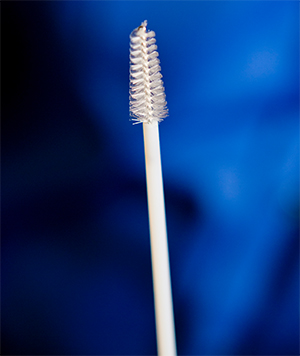Dr. William Reisacher
Several years ago, William R. Reisacher, MD, noticed a perplexing pattern among some of his patients who had airborne and food allergies. “Many of them presented with clinical symptoms suggestive of allergy, and yet their skin-prick tests and serological in vitro tests would come back negative,” says Dr. Reisacher, a Professor of Otolaryngology at Weill Cornell Medicine and an otolaryngic allergist in the Department of Otolaryngology – Head and Neck Surgery at NewYork-Presbyterian/Weill Cornell Medical Center. “I was frustrated, and my patients were frustrated. This would then lead to a conversation about all the other things outside of allergy that could be potentially causing their symptoms, though in the back of my mind, I still thought that there could be some element of allergic disease that was being missed.”
Dr. Reisacher was struck by the fact that that he was testing in areas of the body that were quite distant from the symptomatic regions. “I see many patients who have symptoms in their sinus passageway and in their mouth and throat, yet I was testing their serum or testing on their arm. What has been known for many years is that the lining of the nose, and some other tissues inside the mouth and the throat, can produce all the allergy antibodies that they need in order to produce symptoms, but there is not going to be any evidence of it in the blood or in the skin.”
The ability to test for these antigen-specific antibodies is critical, says Dr. Reisacher, not only for establishing the correct diagnosis, but also to open avenues of treatment. Obtaining samples for local antibodies, however, involved either invasive biopsies or procedures like nasal lavage that only sampled the mucus and were very difficult to obtain in children. This prompted him to develop a less invasive way of testing – a mucosal brush biopsy. Using a cytology brush to collect both mucus and surface epithelial cells of the nasal lining, he then processed those cells using a method he developed to collect the antibodies without destroying them, then testing for those antibodies using blood serum testing equipment recalibrated for saline. That first study was a landmark proof of concept that antigen-specific antibodies inside the nose could be measured using the brush biopsy.
Cytology brush used for mucosal biopsy
“Much of the Immunoglobulin E [IgE] lives in the surface layers of the mucosa, and that’s where the idea came for developing the mucosal brush biopsy [MBB],” he says. “Could we sample some mucosa using a noninvasive soft cytology brush and just brush some of the tissue from the inside of the nose and possibly be able to detect IgE antibodies from that? We’re capturing more of the immune cells and the mucosal cells, which harbor much of the IgE, in a more sensitive and specific fashion.”
Testing a Theory
Dr. Reisacher’s hypothesis disputed clinical thinking at the time that most antibodies, particularly IgE, were produced in the spleen and the mesenteric lymph nodes and then distributed to the region where they were needed. “But that’s now understood not to be correct,” he says. “If you think about it, that would be a more dangerous scenario where IgE was being created centrally and then secreted around the entire body. It’s much safer for the local area to use its own IgE as necessary in each part of the body, whether that be the intestines or the sinonasal passageway. That has been a change in thinking over the last 10 to 20 years.”
Dr. Reisacher has embarked on studies using the mucosal brush biopsy to see if it might represent a novel, less invasive testing method for people with food and airborne allergies, most recently focusing on allergy to peanuts and cat dander.
Peanut Allergy Dr. Reisacher, who himself has suffered from peanut allergy since childhood, conducted a pilot study of the mucosal brush biopsy from the oral cavity as a new diagnostic test for this allergy. Twenty individuals with no history of adverse reactions from eating peanuts underwent oral MBB and serum specific immunoglobin E (sIgE) testing. These data were then compared with previously published data from 10 individuals with a history of clinical peanut allergy to calculate the sensitivity, specificity, and positive and negative predictive values for both testing modalities. The results of the study, which were published in the June 2019 issue of the International Forum of Allergy & Rhinology, showed:
- Optimal cutoff levels for oral MBB and sIgE testing were 0.12 kU/L and 1.0 kU/L, respectively
- At 0.12 kU/L, the sensitivity of oral MBB testing was 80 percent and the specificity was 85 percent, whereas at 1.0 kU/L, the sensitivity of sIgE testing was 50 percent and the specificity was 100 percent
- The areas under the receiving operating characteristic (ROC) curve for oral MBB and sIgE were 0.91 and 0.74, respectively
- Combination testing further increased both sensitivity and accuracy over oral MBB alone
The researchers concluded that oral MBB showed high sensitivity and specificity for screening individuals with and without oral cavity clinical reactivity to peanuts and may possibly represent a useful testing method for the diagnosis of peanut allergy in the future.
Dr. Reisacher has embarked on studies using the mucosal brush biopsy to see if it might represent a novel, less invasive testing method for people with food and airborne allergies, most recently focusing on allergy to peanuts and cat dander.
Cat Allergy In 2021, Dr. Reisacher and his Weill Cornell Medicine colleagues presented data estimating the sensitivity, specificity, and predictive value of nasal MBB for measuring sIgE against cat dander. The most common tests for allergic rhinitis, which affects 10 to 30 percent of adults, are serum IgE detection and skin-prick testing, both of which have significant false positive rates.
MBB has detected local sIgE in people with allergic rhinitis, nonallergic rhinitis, food allergy, and eosinophilic esophagitis. However, sensitivity and specificity estimates for MBB using respiratory allergens had not yet been performed. This study sought to determine optimal testing cutoff levels for accurate environmental control counseling and immunotherapy decisions. The researchers targeted cat dander due to its high prevalence (12.1 percent of the U.S. population) and self-identifiable nature.
The results of this study, which were published in the International Forum of Allergy & Rhinology in February 2021, showed:
- Of the 40 individuals included, 10 were cat reactive
- A significant association between cat sIgE from nasal MBB and clinical reactivity
- Six of 10 reactive participants had sIgE to cat dander on nasal MBB versus 4 of 30 nonreactive participants
The researchers noted, “This preliminary study demonstrates for the first time that sensitivity, specificity, and predictive value of local sIgE testing for cat dander allergy is similar to serum and skin testing. Nasal MBB also predicts clinical reactivity to cats, with a sensitivity, predictive value, and efficiency similar to skin and serum testing.”
Allergen Specific Immunotherapy
“While we have many medications to help with symptoms, they don’t change one’s allergic status. Immunotherapy, however, can,” says Dr. Reisacher. “It involves re-educating and exposing the immune system to the very things that one is allergic to on a regular basis at a high enough dose over a period of about four years.”
Dr. Reisacher and his colleagues conducted a survey of patients at NewYork-Presbyterian/
The findings, which were published in the March 2022 issue of the International Forum of Allergy & Rhinology, indicated that most patients were highly satisfied and willing to recommend immunotherapy to others, regardless of delivery method. The researchers’ analysis demonstrated a significantly increased adherence to immunotherapy in the oral mucosal immunotherapy cohort as compared to the subcutaneous and sublingual groups, likely due to its seamless integration in a patient’s daily routine through tooth brushing.
“Many people, patients and physicians alike, believe that there’s nothing that can be done for allergies, and nothing could be further from the truth,” adds Dr. Reisacher. “Immunotherapy has advanced in a major way from the days when only injections were available. There are many user-friendly options for desensitizing people, which start working within a few months. A four-year cycle can give people decades of relief.”






